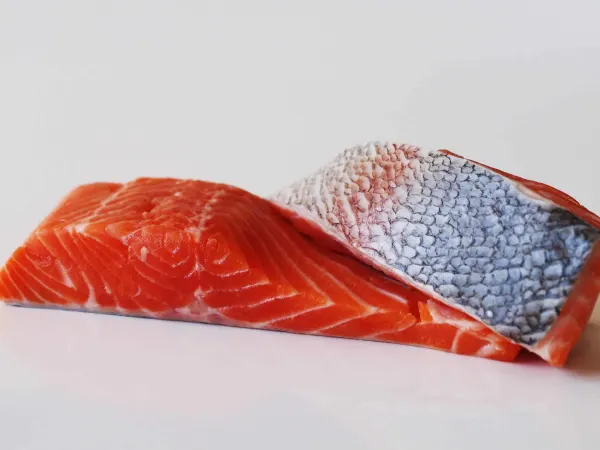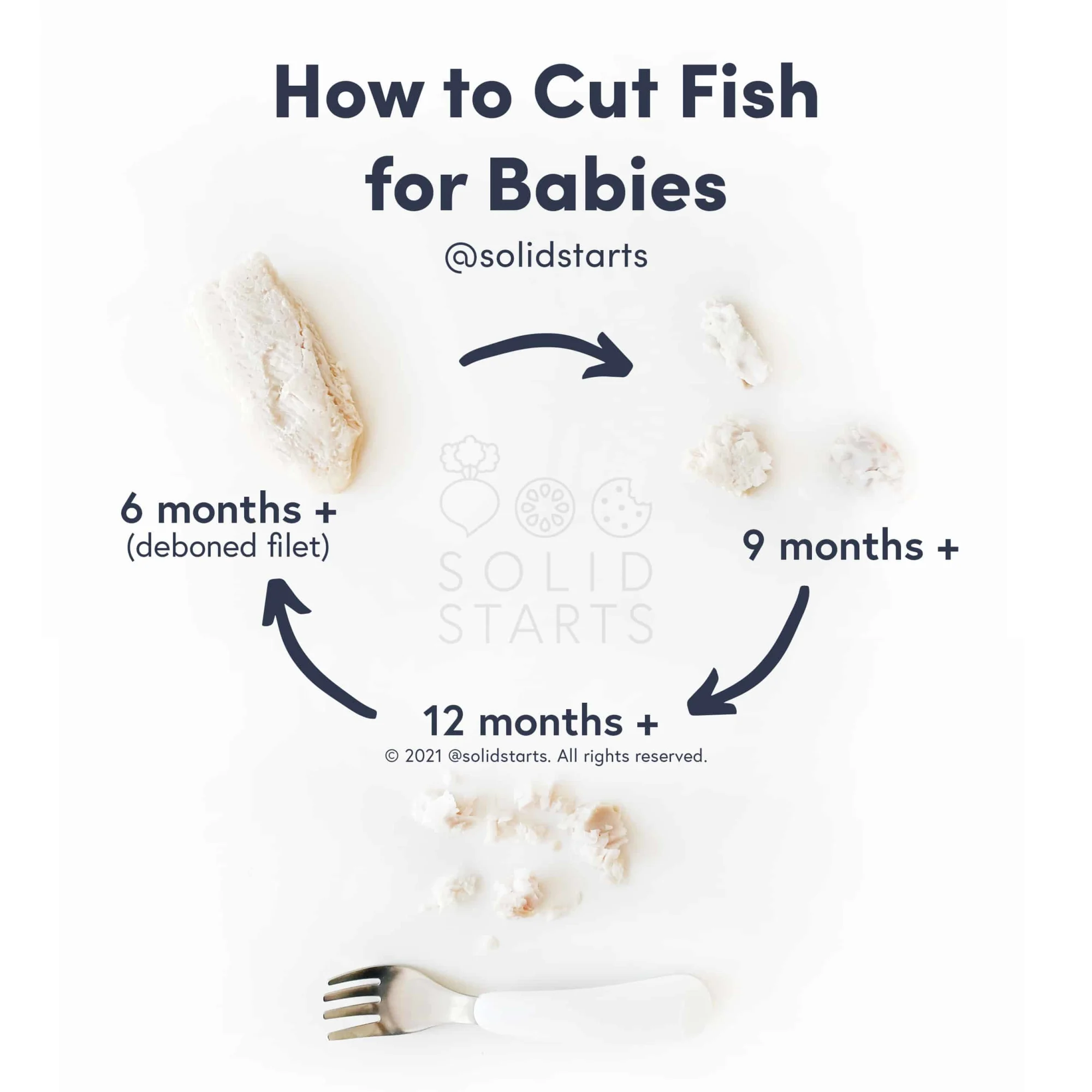Trout
Fish (Finned)
Age Suggestion
6 months
Iron-Rich
No
Common Allergen
Yes

When can babies eat trout?
Trout may be introduced as soon as baby is ready to start solids, which is generally around 6 months of age. Steelhead trout and farmed rainbow trout are rated as a “best choice” in our guide, Best & Worst Fish for Babies. Compared to other fish, these trout are low in mercury and considered safe for babies 2-3 times per week. Avoid lake trout, which can be considerably high in mercury.
Hold off on serving smoked trout until after baby’s first birthday, as it often contains sodium levels in excess of what babies need. Pickled trout is often made from raw trout and is best avoided until a child is older due to the increased risk of foodborne illness associated with the consumption of raw fish.
Where do trout live?
Inhabiting cool waters of lakes, rivers, and coastal zones are brookies, cutthroats, namaycush, steelheads, and many other species of trout—a sprawling group of oily finned fish within the same family as char and salmon. Typically smaller than deep-water ocean fish, trout protect themselves from predators with camouflaged skin, some with speckled backs and silver bellies, and others striped with colorful streaks in any hue of the rainbow. Some trout are truly wild, while others come from farms, which not only raise fish for sale to consumers, but to replenish overfished waters.
Videos
Is trout healthy for babies?
Yes, if fresh or frozen. This fish is a great source of vitamin B12, protein, and omega-3 fatty acids, which are important in supporting baby’s brain development. Trout also contains vitamin D, which supports the growth of healthy bones and cells, and selenium for a healthy immune system. These nutrients are particularly important for babies and can be hard to obtain from other foods.
Due to pollution in our waters, all fish, including trout, contain variable amounts of mercury. Mercury is a persistent and progressive toxin to which babies are particularly susceptible. Thankfully there are lots of fish that are low in mercury that babies can enjoy, including steelhead and farmed rainbow trout. It is also wise to check your local fish advisories for trout that is caught by friends or family, as the risk of mercury contamination can vary by body of water. Ultimately, to minimize baby’s exposure to mercury from fish, prioritize fish that are lowest in mercury and limit the amount and frequency of fish that have higher amounts of mercury. For this reason, avoid serving lake trout in baby’s first year of life and minimize exposure to the fish in toddlerhood and beyond, as this variety can be high in mercury.
Hold off on smoked trout until after a child’s first birthday, and even then, serve on occasion, as it is often high in sodium. Look for products with less than 100 milligrams of sodium per serving and/or rinse the fish with water, which can remove up to 80% of sodium in certain varieties of water-packed canned fish. In addition, bisphenol A (BPA) is used to line the interior of food containers, and studies show that frequent exposure can disrupt a baby’s bodily functions. Look for cans marked “BPA-free,” when available, or opt for trout in glass jars. Pickled trout is often made from raw trout and is best avoided until after baby’s first birthday due to the increased risk of foodborne illness associated with the consumption of raw fish.
Is wild-caught trout better than farmed trout?
It is complicated. Farmed trout typically contains lower levels of mercury than wild-caught trout, but both farmed and wild-caught trout are among the best fish for babies because they contain less mercury than popular fish like cod, swordfish, and tuna. Both farmed and wild-caught trout have an impact on the environment, and it is difficult to claim that one is better than the other. To prioritize the environment, consider seeking out a supplier of trout who prioritizes sustainability, if one is accessible to you. At the end of the day, do the best you can with what is available and know that trout, farmed or wild, is a nutritious food as part of a balanced and varied diet.
Is trout a common choking hazard for babies?
No. Trout is not a common choking hazard, though bones in fresh fish are if not removed. To minimize the risk, be sure to pick out any lingering bones before serving. As always, make sure you create a safe eating environment and stay within an arm’s reach of baby during meals. For more information on choking, visit our sections on gagging and choking and familiarize yourself with the list of common choking hazards.
Is trout a common allergen?
Yes. Finned fish are classified as a Global Priority Allergen by the World Health Organization. It is estimated that only 0.2 percent of people are allergic to finned fish worldwide, and the prevalence of fish allergies in children, while variable, is even less than in adults. About 40 percent of people with finned fish allergies don’t experience their first allergic reaction until adulthood. Unfortunately, most individuals who are allergic to finned fish do not outgrow the allergy.
Some individuals with finned fish allergy may react from inhaling airborne proteins that are aerosolized when cooking fish. If this is the case for baby, you may wish to avoid cooking fish in the household when baby is present.
Around 50% of individuals with one finned fish allergy will react to another fish as well. This is because the major allergen in finned fish, beta-parvalbumin, is present in most fish, regardless of species. Due to the risks of cross-contamination or mislabeling, allergists often recommend that those allergic to one species of finned fish avoid all finned fish until meeting with an allergist to determine which fish might be safely introduced into the diet. This is an individualized recommendation, so be sure to confirm with your allergist before offering other finned fish if baby is allergic to trout.
Finned fish are a known trigger of food protein-induced enterocolitis syndrome, also known as FPIES. FPIES is a delayed allergy to food protein which causes the sudden onset of repetitive vomiting and diarrhea to begin a few hours after ingestion. Left untreated, the reaction can result in significant dehydration. Unlike other food allergens, FPIES to finned fish may not present until later in life, and tends to be life-long.
Lastly, a note on scombroid poisoning, which is sometimes mistaken for a fish allergy. Scombroid poisoning is a type of food poisoning that occurs when someone eats fish that has been improperly refrigerated. This allows a large amount of histamine to build up in the fish. When consumed, this large load of histamine can cause symptoms that mimic those of an allergic reaction, causing some people to believe that they have developed a finned fish allergy, even if they are not allergic. Ensuring that fish has been stored at adequately cool temperatures can minimize the risk of such a reaction.
If you suspect baby may be allergic to fish, consult an allergist before introducing trout. As with all common allergens, introduce trout in small amounts at first and watch closely as baby eats to see if any adverse reaction occurs. If all goes well, gradually increase the serving size over time. Once common food allergens are successfully introduced, it is recommended to keep them in the diet regularly (twice weekly, if possible). However, this doesn’t mean that each different fish species must be offered multiple times a week - finned fish share the same major proteins, so it is perfectly acceptable to rotate finned fish varieties according to availability and preference.
Recommended Guide: Introducing Allergens
Can trout help baby poop?
Trout isn’t generally thought of as a food that promotes pooping. That said, it can play an important role in healthy bowel movements as part of a varied diet. Diets featuring fish like trout may promote the presence of beneficial bacteria, like Lactobacillus, which contributes to a healthy and diverse gut microbiome. Pooping patterns can vary significantly from child to child, so be sure to talk to your pediatric healthcare provider if you have concerns about baby’s pooping or digestive function.
What are recipe ideas for cooking with trout?
Trout can be used in any recipe that calls for salmon, which means you can bake, braise, grill, fry, poach, roast, steam, or stew this oily fish with your favorite seasonings. Trout tastes rich from all the oils in its flesh—a flavor that pairs well with tangy sauces like chermoula, salsa verde, romesco, and tzatziki. You can also mash cooked trout as a substitute for tuna in bakes, casseroles, and salads. When you’ve got a trout fillet with the skin intact, try grilling or pan-searing the fish with the skin side facing the heat so that it becomes crispy and tasty like bacon. You can do the same with a whole fish, and don’t forget to eat the fish cheeks, eyes, and roe—deliciously rich parts of the fish that are considered to be a delicacy in many cultures.
How do you prepare trout for babies with baby-led weaning?
Every baby develops on their own timeline, and the suggestions on how to cut or prepare particular foods are generalizations for a broad audience.
6 to 9 months old:
Start with fresh or frozen (not canned, pickled, or smoked) trout and double check that bones and skin are removed and that the fish is fully cooked to 145 degrees Fahrenheit (63 degrees Celsius). Offer baby strips of fish about the size of two adult fingers pressed together. Know that the trout will likely fall apart in baby’s hands, and that’s okay. They only have the fine motor skills to pick up pieces that are developmentally appropriate and bring them to the mouth. As the fish falls apart in the mouth, you may see some harmless gagging as well. You can also flake apart cooked trout (bones and skin removed) and mix the flakes into a soft, scoopable food like mashed potatoes for baby to self-feed.
9 to 12 months old:
At this age, babies develop the pincer grasp (where the thumb and forefinger meet), which enables them to pick up smaller pieces of food. When you see signs of this development, offer bite-sized pieces (think the size of a large adult knuckle) of cooked trout (bones and skin removed) for baby to practice picking up, or you can continue offering strips of fish. Or, cook trout in the form of cakes and patties that baby can grab and munch on.
12 to 24 months old:
Toddlers often begin to develop more noticeable food preferences at this stage. Build familiarity with trout by serving it in different ways that introduce the concept that the fish can taste differently depending on how it is prepared. Serve trout on its own or as part of a dish, either as finger food or for utensil practice. If you’d like to introduce smoked trout at this age, just serve in moderation, as cured and smoked fish tends to be high in sodium.
For more, see the Solid Starts Fish guide—the world’s only guide to seafood for babies and toddlers.
Our Team
Written by
Expert Tips Delivered to Your Inbox
Sign up for weekly tips, recipes and more!
Copyright © 2024 • Solid Starts Inc






